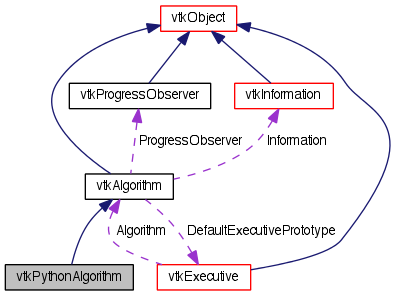algorithm that can be implemented in Python More...
#include <vtkPythonAlgorithm.h>


Public Types | |
| typedef vtkAlgorithm | Superclass |
Public Member Functions | |
| virtual int | IsA (const char *type) |
| vtkPythonAlgorithm * | NewInstance () const |
| void | PrintSelf (ostream &os, vtkIndent indent) |
| void | SetPythonObject (PyObject *obj) |
| virtual void | SetNumberOfInputPorts (int n) |
| virtual void | SetNumberOfOutputPorts (int n) |
Static Public Member Functions | |
| static vtkPythonAlgorithm * | New () |
| static int | IsTypeOf (const char *type) |
| static vtkPythonAlgorithm * | SafeDownCast (vtkObjectBase *o) |
Protected Member Functions | |
| virtual vtkObjectBase * | NewInstanceInternal () const |
| vtkPythonAlgorithm () | |
| ~vtkPythonAlgorithm () | |
| virtual int | ProcessRequest (vtkInformation *request, vtkInformationVector **inInfo, vtkInformationVector *outInfo) |
| virtual int | FillInputPortInformation (int port, vtkInformation *info) |
| virtual int | FillOutputPortInformation (int port, vtkInformation *info) |
Detailed Description
algorithm that can be implemented in Python
vtkPythonAlgorithm is an algorithm that calls a Python object to do the actual work. It defers the following methods to Python:
Python signature of these methods is as follows:
- ProcessRequest(self, vtkself, request, inInfo, outInfo) : vtkself is the vtk object, inInfo is a tuple of information objects
- FillInputPortInformation(self, vtkself, port, info)
- FillOutputPortInformation(self, vtkself, port, info)
- Initialize(self, vtkself)
In addition, it calls an Initialize() method when setting the Python object, which allows the initialization of number of input and output ports etc.
- See also:
- vtkProgrammableFilter
Definition at line 52 of file vtkPythonAlgorithm.h.
Member Typedef Documentation
Reimplemented from vtkAlgorithm.
Definition at line 56 of file vtkPythonAlgorithm.h.
Constructor & Destructor Documentation
| vtkPythonAlgorithm::vtkPythonAlgorithm | ( | ) | [protected] |
| vtkPythonAlgorithm::~vtkPythonAlgorithm | ( | ) | [protected] |
Member Function Documentation
| static vtkPythonAlgorithm* vtkPythonAlgorithm::New | ( | ) | [static] |
Create an object with Debug turned off, modified time initialized to zero, and reference counting on.
Reimplemented from vtkAlgorithm.
| static int vtkPythonAlgorithm::IsTypeOf | ( | const char * | name | ) | [static] |
Return 1 if this class type is the same type of (or a subclass of) the named class. Returns 0 otherwise. This method works in combination with vtkTypeMacro found in vtkSetGet.h.
Reimplemented from vtkAlgorithm.
| virtual int vtkPythonAlgorithm::IsA | ( | const char * | name | ) | [virtual] |
Return 1 if this class is the same type of (or a subclass of) the named class. Returns 0 otherwise. This method works in combination with vtkTypeMacro found in vtkSetGet.h.
Reimplemented from vtkAlgorithm.
| static vtkPythonAlgorithm* vtkPythonAlgorithm::SafeDownCast | ( | vtkObjectBase * | o | ) | [static] |
Reimplemented from vtkAlgorithm.
| virtual vtkObjectBase* vtkPythonAlgorithm::NewInstanceInternal | ( | ) | const [protected, virtual] |
Reimplemented from vtkAlgorithm.
Reimplemented from vtkAlgorithm.
| void vtkPythonAlgorithm::PrintSelf | ( | ostream & | os, |
| vtkIndent | indent | ||
| ) | [virtual] |
Methods invoked by print to print information about the object including superclasses. Typically not called by the user (use Print() instead) but used in the hierarchical print process to combine the output of several classes.
Reimplemented from vtkAlgorithm.
| void vtkPythonAlgorithm::SetPythonObject | ( | PyObject * | obj | ) |
Specify the Python object to use to operate on the data. A reference will be taken on the object. This will also invoke Initialize() on the Python object, which is commonly used to set the number of input and output ports as well as perform tasks commonly performed in the constructor of C++ algorithm subclass.
| virtual void vtkPythonAlgorithm::SetNumberOfInputPorts | ( | int | n | ) | [virtual] |
Set the number of input ports used by the algorithm. This is made public so that it can be called from Python.
Reimplemented from vtkAlgorithm.
| virtual void vtkPythonAlgorithm::SetNumberOfOutputPorts | ( | int | n | ) | [virtual] |
Set the number of output ports provided by the algorithm. This is made public so that it can be called from Python.
Reimplemented from vtkAlgorithm.
| virtual int vtkPythonAlgorithm::ProcessRequest | ( | vtkInformation * | request, |
| vtkInformationVector ** | inInfo, | ||
| vtkInformationVector * | outInfo | ||
| ) | [protected, virtual] |
Upstream/Downstream requests form the generalized interface through which executives invoke a algorithm's functionality. Upstream requests correspond to information flow from the algorithm's outputs to its inputs. Downstream requests correspond to information flow from the algorithm's inputs to its outputs. A downstream request is defined by the contents of the request information object. The input to the request is stored in the input information vector passed to ProcessRequest. The results of an downstream request are stored in the output information vector passed to ProcessRequest. An upstream request is defined by the contents of the request information object. The input to the request is stored in the output information vector passed to ProcessRequest. The results of an upstream request are stored in the input information vector passed to ProcessRequest. It returns the boolean status of the pipeline (false means failure).
Reimplemented from vtkAlgorithm.
| virtual int vtkPythonAlgorithm::FillInputPortInformation | ( | int | port, |
| vtkInformation * | info | ||
| ) | [protected, virtual] |
Fill the input port information objects for this algorithm. This is invoked by the first call to GetInputPortInformation for each port so subclasses can specify what they can handle.
Reimplemented from vtkAlgorithm.
| virtual int vtkPythonAlgorithm::FillOutputPortInformation | ( | int | port, |
| vtkInformation * | info | ||
| ) | [protected, virtual] |
Fill the output port information objects for this algorithm. This is invoked by the first call to GetOutputPortInformation for each port so subclasses can specify what they can handle.
Reimplemented from vtkAlgorithm.
The documentation for this class was generated from the following file:
- /Users/kitware/Dashboards/MyTests/VTK_BLD_Release_docs/Utilities/Doxygen/dox/Filters/Python/vtkPythonAlgorithm.h
 1.8.0
1.8.0